Dindle Keep – Level 1
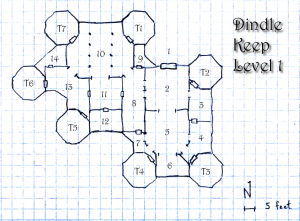 The party will arrive from the trail to the south, having had the guards in the toll houses far below signal up that they en route on business. This trail wraps around the front of the keep, which is inaccessible from the side facing the road.
The party will arrive from the trail to the south, having had the guards in the toll houses far below signal up that they en route on business. This trail wraps around the front of the keep, which is inaccessible from the side facing the road.
Note of course that if the party is caught stealing anything or is deemed dangerous and unfriendly by Silas, the guards will attack the party, taking custody of them, and preparing them for delivery to Jæruel headquarters in Tannen.
If the party decides to sneak into the keep at night, Silas will be sleeping up in his room, his daughters both awake and sending messages to one another through a series of taps on the walls. Guards will be posted in many of the towers, in the entry hall, and outside their three rooms, two for Silas, and one for each of his daughters.
Towers – each of the hexagonal towers contains a small bed a the bottom of a staircase leading up. There is no level to the keep below ground; the bedrock was too hard to easily build into when the keep was built over a hundred years ago.
1 Outside the Keep
The tall door leading into the keep is nestled in between two towers on the uphill side of the keep. Tight clusters of cypress line the walls in patches along a neatly-fitted brick and stone walkway. The tall door is emblazoned with the emblem of the profile of a woman’s head and shoulders on a deep yellow shield. A man in impressive field plate with the same emblem upon it steps forward, says “Ho!” and waits for the party to bow.
Once they do, he steps forward, introducing himself as Lanx and holding his arm out, pointing the way to the door.
2 Entrance Hall
As the party approaches, read the following:
The oversized door creaks on its hinges as it opens, leading into the keep from the uphill side. A man who introduces himself as Lanx bids the party, “Welcome to Dindle Keep. Keep your troubles outside!” As everyone steps through the door, two armed guards wield the heavy portal and latch it shut with a large caber. They turn to watch the party.
3 Study
This moderately-sized room is lined with short bookshelves. Atop the shelves are various houseplants taken from the fields and forests in the local region. Upon the walls are landscape oil and watercolor paintings of sunrises and sunsets in brilliant hues. A lone candelabra illuminates a table in the center of the room. A book lies open in the central reading chair.
The book is on the local folklore, containing small, hand-drawn maps from storytellers. There are annotations pencilled into the margins, and the names of places underlined.
In the early evenings, Silas retires to the study to improve his knowledge of history, geography, and religion. He will be found here if visited in the evening.
4 Library
An impressive collection of books lines the walls of this room, the leather spines like the scales of a dragon. In the center of the room is a large table upon which rest a collection of maps.
If thoroughly searched, the party will find books on the local geography and history, which if studied, raise those skills by a point each.
5 Statuarium
Worn, humanoid statues occupy the two hard corners of the room, with the far walls coming together at 45 degree angles toward the rest of the keep. The stone ceiling rises another two feet above the floor to accommodate the tall statues.
The two statues have the emblem of the Dindle family etched in them. A careful inspection of the statues reveals small sets of wings on both of them, jutting out just past the shields slung over their backs. This hints at a relationship with the celestial.
6 Back Chamber
Passing under another large arch, the wooden ceiling lowers to a more normal height. A stone fireplace occupies the center of the exterior wall, with a gold leaf framed, life-sized oil rendition of a middle-aged man eerily staring out across the keep back toward the entrance.
7 Small Hall
Between two arches, modest paintings of former denizens of the keep find refuge in a dark corridor with wooden doors at either end.
Artistic renditions of multiple generations are represented in the frames. In a hidden alcove behind one of the paintings of the twin girls is a key ring with extra keys to each of their rooms (on Level 2).
8 Wide Hallway
Paintings of old relatives line this wide hallway, including as the most illuminated one, labeled “Lady Dindle.” Doors are set in opposite ends of the hall, and one is also set in the center of the hall. Three archways keep the hall fairly open-feeling, like the rest of the keep.
If the painting is studied in any detail, read the following:
Lady Dindle was an beautiful, yet austere woman. These traits come out in her appearance, with a scornful scowl scratching the surface of her glowing skin.
9 Closet
This moderately-sized closet is adorned with wood-paneled walls. Jacket, coats, mittens, hats, two sleds, tack, and other sundries are hung here on various metal hooks that jut from the walls.
Treasure: In the pocket of one of the jackets is a pair of gloves of storing.
10 Throne Room
Eight alabaster columns line the fine carpet leading up to a pair of sitting chairs etched with the Dindle arms.
If it is daytime, and there are guests in the keep, Silas will be here, providing them an audience. If Silas is here, he will be flanked by two guards armed with swords at their sides. Merchants pass through, bringing stories, which Silas is eager to hear. He has been known to reduce the toll on the road for those who provide him with quality entertainment. (more in a later post)
Treasure: A masterwork instrument called the Silverhorn hangs to the right side of the throne.
11 Dining Room
A large table is set in the center of the room, requiring everyone to walk along the walls to navigate the space. A large brass candelabra rests upon the table, illuminating the room in a warm glow. Along the floor, paralleling the impressive table, is a finely-woven rug.
Treasure: The rug is worth 1500gp, the candelabra 500gp.
12 Den
Small tables and chairs are tastefully laid out in the room facing each other, with a simple rug in the center.
Treasure: There are a few loose coins in the seat of the chairs.
13 Kitchen
Years of caked on grease and other food cling to the walls, leaving them black toward the ceiling, where a tapered ceiling has led thousands of plumes of smoke out of the keep. A large oven and multiple stoves line the exterior brick walls of this room. Pots and pans hang suspended from the ceiling in the center of the room.
Various foodstuffs can be found throughout the kitchen.
14 Pantry
This oddly-shaped, dusty room is full of large crates, barrels, and bags of flour and wheat. Tiny flour footprints lead in all directions.
Creature: There are 3 large rats in this room.
Treasure: A potion of charm person lies at the bottom of a crate otherwise full of hay.
Posted in Uncategorized and tagged Jæruel, keep, Location by Stephen Hilderbrand with no comments yet.
Feather of Falling
 This feather is plucked from a flying creature’s wing, and is enchanted with a featherfall spell. It acts exactly like a feather fall spell, activated immediately if the wearer falls more than 5 feet.
This feather is plucked from a flying creature’s wing, and is enchanted with a featherfall spell. It acts exactly like a feather fall spell, activated immediately if the wearer falls more than 5 feet.
Faint enchantment; CL 1st; feather of a flying creature; featherfall; Price 1,800 gp.
Posted in Magic Item and tagged enchantment, feather by Stephen Hilderbrand with no comments yet.
The Story of Silas Dindle
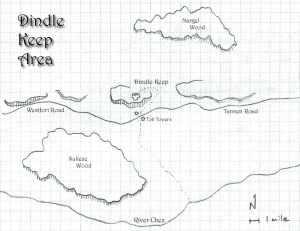 Silas Dindle is a local baron with a keep along the road between Tannen and Chez. The small barony has profited from the trade route that runs from Westfort to the capital.
Silas Dindle is a local baron with a keep along the road between Tannen and Chez. The small barony has profited from the trade route that runs from Westfort to the capital.
Lately Silas has been acting strange, insisting that his twin teenage daughters (who look only remotely alike) remain in his keep out of fear of having it overrun with goblins if they leave. It’s as if he sees them as guardians of the keep, though he employs a full retinue of soldiers to guard the keep itself. This has created some friction between him and his daughters, who wish to travel to Tannen to enjoy the prime of their youth. The Jæruel is beginning to threaten to step in if he is unable to gain control of the situation and explain why his daughters cannot leave the keep and why his men have been unable to provide escorts along the nearby roads. They too have been pressed into a new service, that of protecting the daughters so they can protect the keep.
Lady Dindle is long gone; she died during their birth some fifteen years ago. Silas has mourned her ever since. If the party visits the small graveyard at the rear of the castle, they will learn this, and her ghost will visit the party and tell her side of the story, a tale of wanting to keep her man happy while at the same time losing herself in him. They were unable to conceive, and instead she was impregnated by one of his god’s angels, giving birth to the half-angel beings that protect the keep. At least that’s her side of the story.
Plot Resolution
It turns out, they were able to conceive, but Lady Dindle died with the twin daughters, who were replaced with angels (Antaigne and Emmaigne) on earth due to Silas’ devout nature. Recent events, including his joining the Jæruel have led him to question his god and perform acts which are considered less devout by his god’s followers, including overtolling the local merchants and imprisoning a merchant who asked for one of his daughters’ hands (Emmaigne, the younger of the two) in marriage. The party will need to restore Silas’ faith by helping him perform a series of heroic deeds. This will enable him to retain the angels and thus his sense of fatherhood, and maintain a reason for living.
(map of the keep to follow in a later post)
Posted in Encounter and tagged campaign plotline, Jæruel by Stephen Hilderbrand with no comments yet.
Aldric Tréburne, Level 6
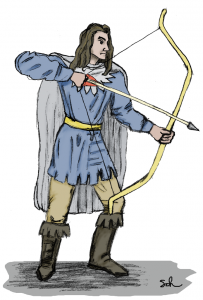 Older brother of Kilmore Tréburne, Aldric stayed home to care for the ailing family while Kilmore went forth in search of adventure. Now that the family is stabilized, thanks to Avandra’s blessings, Aldric has now left home in search of his brother and his own adventure.
Older brother of Kilmore Tréburne, Aldric stayed home to care for the ailing family while Kilmore went forth in search of adventure. Now that the family is stabilized, thanks to Avandra’s blessings, Aldric has now left home in search of his brother and his own adventure.
Along the way, he has met up with an eldarin war wizard and traveled from town to town, lending healing powers and fighting off brigands and ferocious wolves.
A playful, yet grounded, working-class elf, Aldric has developed many talents, though none that he pursues with more passion than his faith in Avandra, and healing in her name. he has been called too humorous for serious elven service, and too ill-mannered to ever represent his people abroad, so his only hope is in following his own dreams and desires.
He maintains his own gear, but is not too proud to ask for help in repairing or caring for it. His most prized possessions are a pair of ornate, buckled catgrace boots, a finely-carved shortbow +1 thunderburst, and his holy symbol of Faith to Avandra (+1d6 healing).
In addition, he wears a suit of chainmail with a small cape and carries an adventurer’s kit in a backpack.
Recently, he has taken up visiting a few of Avandra’s shrines, recently heading from Thelka’s shrine tpo Avandra down the River Daren to Cerest, where he helped take the keep from an army of orcs.
Aldric in your game: Aldric tells a decent tale, and with his diplomacy will likely have learned some things about the local area. As a healer, he is likely to have learned much of the recent adventurers of others. Aldric could serve as an NPC in a party that did not have a player in the leader role. He would allow the DM to give the party some extra healing without having a character overly bent on seeing his own will done.
Aldric Tréburne: Level 6 Cleric of Avandra
medium fey humanoid – XP 7,500
age (equivalent of 28 in human years)
height 5’10”, weight 155, brown hair, green eyes
Initiative +10 Senses Perception +7
HP 50; Bloodied 25 Healing Surges: 9
AC 19, Fortitude 16, Reflex 18, Will 18
Speed 7
Powers
Channel Divinity:
* Healer’s Lore
* Healing Word (2/Encounter)
* Divine Fortune
* Turn Undead
At-Will:
* Lance of Faith
* Sacred Flame
Encounter:
* Elven Accuracy
* Command
Daily:
* Beacon of Hope
* Weapon of the Gods
Utility:
* Shield of Faith
* Bastion of Health
Basic Attacks
Short sword: +10 vs AC, 1d6 + 1 damage
Short Bow +1 thunderburst (40 arrows): +10 vs AC, 1d8 + 3 damage
Alignment Good
Languages Common, Elven
Skills: Arcana 8, Athletics 5, Bluff 3, Diplomacy 8, Dungeoneering 4, Endurance 4, Heal 10, History 7, Insight 5, Intimidate 3, Nature 5, Perception 7, Religion 9, Stealth 6, Streetwise 3, Thievery 3
Feats: Elven Precision, Avandra’s Rescue, Improved Initiative, Ritual Caster
Str 12 Dex 16 Wis 16
Con 13 Int 11 Cha 14
Possessions:
Chain Mail
Short Bow +1 Thunderburst
Short Sword
Light Shield
Adventurer’s Kit
Holy Symbol of Life
2 Healing Potions
720 gp
Posted in Character by Stephen Hilderbrand with no comments yet.
Durst Muqutad
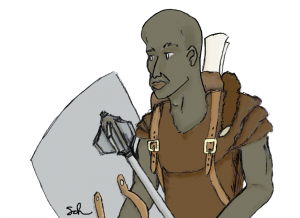 Durst Muqutad is a fighter for hire. Though somewhat aloof, he maintains a gentile manner and general curiosity about the way the world works. Hailing from the edge of a large desert, he has learned to speak the trade and martial languages from those cultures. A relentless fighter, he rarely tires during combat, and has the appearance of someone worth his pay.
Durst Muqutad is a fighter for hire. Though somewhat aloof, he maintains a gentile manner and general curiosity about the way the world works. Hailing from the edge of a large desert, he has learned to speak the trade and martial languages from those cultures. A relentless fighter, he rarely tires during combat, and has the appearance of someone worth his pay.
Durst in your game: Use Durst as a straight-forward fighter-for-hire in your adventure. His motives are simple – he works for money and has an long-term quest to find his brother, Alaham. If he meets adventurers who may assist him, he will work for free (well, in game terms, a share of the XP).
Durst Muqutad
Level 2 Neutral Fighter (follower of Erathis)
XP: 1,290
medium human
Age: 40
Height: 6’2″
Weight: 195
Appearance: brown hair with grey streaks, brown eyes, salt and pepper beard
Initiative: +2
Perception: +1
HP: 38; Bloodied 19 Healing Surges: 12
AC: 17, Fortitude 14, Reflex 13, Will 11
Speed: 6
Powers
Combat Challenge
Combat Superiority
Fighter Weapon Talent (one-handed)
At-Will:
* Cleave
* Tide of Iron
Encounter:
* Spinning Sweep
Daily:
* Brute Strike
Utility:
* Unstoppable
Basic Attacks
Mace: +6 to hit, 1d8+3 dmg
Alignment: Neutral
Languages: Common, Desert Tongues from his home region
Skills: *Athletics 9, Bluff 1, Diplomacy 1, Dungeoneering 1, *Endurance 9, Heal 1, History 2, Insight 1, *Intimidate 6, Nature 1, Perception 1, Religion 2, Stealth 3, Streetwise 1, Thievery 3
* trained
Feats: Shield Push, Power Attack
Str 16 Dex 14 Wis 11
Con 17 Int 12 Cha 10
Possessions:
Hide armor
Heavy shield
Mace
Standard Adventurer’s Kit
3 Sunrods
Silk rope
2 Healing Potions
134 gp
Posted in Character by Stephen Hilderbrand with no comments yet.
Scholar
Living physically sheltered lives in cloisters and monasteries, these true monks known as scholars receive exemplar educations. Others call them bookish, but when the need for ancient knowledge or other long-dead lore arises, they are often the only ones able to provide the proper perspective for the situation.
Adventures: Adventuring is often the first “real-life” experience these scholars have seen. They are not suited to travelling alone, and usually travel in groups of scholars or in mixed parties. Scholars are well-suited to stepping forward when the time is right, an then slinking back to the middle of the group when battles break out. They tend to have a distaste for combat and war in general, and often attempt to convince those around them to put down their weapons unless the need is dire.
Characteristics: The scholar is often an excellent advisor, except in situations outside their training. They often become diplomats when they find their niches, but until then remain frustrated when others do not respond favorably to their recommendations.
Alignment: Scholars are nearly always lawful or true neutral, believing in the truth of their theoretical studies over the messiness of reality. Occasionally a scholar will go rogue, developing a chaotic neutral or evil alignment, and there is no penalty for this change of alignment.
Religion: Many scholars received their initial training in monasteries and other religious settings, so they tend to begin following a religious regimen. However, as they move from their initial place of worship and experience more of the world, many drift from the devout and take on more secular beliefs. Since their powers are almost entirely secular, this change incurs very little penalty, unless the scholar had acquired a significant amount of knowledge from a divine agent. Such knowledge may be removed from the scholar if the deity in question is angered by lack of devotion.
Background: Scolars come from regimented lives of academic toil, where three meals are prepared daily, and where the discussion of strange and lesser-known ideas is commonplace. A scholar may be spurred into adventure by a quest to learn about an undocumented part of the world, or to acquire some artifact they have researched. They may also seek first-hand accounts of events and people. Scholars may also be forced out of their simple lives by the closing of an academy or monastery, either by war, famine, or flood.
Races: Any race can produce a scholar. Elves are particularly adept at scholarship due to their intelligence and long life. Gnomes are also well known for producing scholars. Human scholars are able to blend in the most, and are the most common race among scholars.
Other Classes: Scholars are most comfortable around classes which prefer knowledge over might. Thus, they feel most at home among wizards, sorcerors, and clerics. However, they have been known to partner with rogues, especially when they seek artifacts which are held behind arrays of traps, locks, and riddles. In addition, they have been known to take jobs as advisors to diplomats and leaders, where they can dispense their knowledge without scorn and ridicule. Other classes are not always to welcoming of their unique perspective.
Role:A scholar’s primary role is that of note-taker and researcher. No other characters pay as close attention to detail as scholars, and none has the mental acumen to put to the task.
Game Rule Information
Scholars have the following game statistics.
Abilities: Intelligence and wisdom are the two abilities treasured most by scholars. As such, they tend to be weaklings and klutzes, stumbling around the battlefield. A high charisma makes them more likely to find work as advisors, and thus live long enough to avoid the battlefield.
Alignment: Usually lawful and neutral, but any are possible. In general, the more chaotic, the worse the scholar at performing the critical tasks for which they are known.
Hit Die: d4
Class Skills
The scholar’s class skills are: Alchemy, Bluff, Concentration, Craft, Decipher Script, Diplomacy, Forgery, Knowledge (any), Profession, Ride, Rope Use, Search, Sense Motive, Use Magic Device
Skill Points at 1st Level: (8 + Int modifier) x 4.
Skill Points at Each Additional Level: 8 + Int modifier
Class Features
All of the following are class features for the scholar.
Weapon and Armor Proficiency: Scholars are proficient with all simple weapons. They are not proficient with armor or shields. Armor tends to get in the way of their research. However, some scholars have devoted time (a feat slot) to learning how to wear armor for better protection when they find themselves on the battlefield.
Read Arcane and Divine Magic: At first level, scholars can read both arcane and divine magic. This does not bestow upon them the ability to cast spells.
Write Arcane and Divine Magic: At second level, scholars can write both arcane and divine magic. This does not bestow upon them the ability to cast spells.
Research: At third level, scholars can perform research in large information repositories, such as libraries and the Plane of Knowledge, receiving a +5 bonus to gather information or on knowledge checks in these environments.
Spells: Beginning at fourth level, scholars acquire spells according to the Paladin table on page 43 of the PHB. These spells can be either arcane or divine. In addition, scholars receive additional spells based on their Int and Wis bonuses, as per wizards, sorcerors, and clerics. Scholars choose one cleric domain and receive one free spell and power per day as per their chosen domain.
Advanced Research: At 7th level, scholars can perform research in large information repositories, such as libraries and the Plane of Knowledge, receiving a +10 bonus to gather information or on knowledge checks in these environments.
Plane Shift to and from the Plane of Knowledge: At 9th level, scholars can plane shift to the Plane of Knowledge. This requires 10 minutes to cast, and requires reading a passage aloud from a book of knowledge.
Posted in Uncategorized and tagged class, npc class by Stephen Hilderbrand with no comments yet.
Silken Scarf
 These come in many varieties, colors, and textures. Most are smooth, and of a solid color or a basic pattern. The more exotic the scarf, the more powerful the incantation. In order to activate the magic contained in the scarves, the wearer must place them over their mouth, usually accomplished by wrapping them around the neck and slinging them over the mouth. When not activated, they serve a decorative purpose.
These come in many varieties, colors, and textures. Most are smooth, and of a solid color or a basic pattern. The more exotic the scarf, the more powerful the incantation. In order to activate the magic contained in the scarves, the wearer must place them over their mouth, usually accomplished by wrapping them around the neck and slinging them over the mouth. When not activated, they serve a decorative purpose.
Common silken scarves include:
* Black – invisibility
* White – protection from evil
* Green – sustenance
* Blue – water breathing
* Red – fire resistance +5
* Gold – diplomacy +5
* Silver – bull’s strength
Of course, these common options are supplemented by various variations upon themes, for as varieties of silken threads are woven together in different patterns, different wondrous results arise, not unlike the variations found in alchemy and potion-making.
The price of silken scarves varies, based on the nature of the enchantments upon them. In general, the more complex the pattern, the more enchantments, and thus the more expensive the silken scarf. To craft a silken scarf, one must start with enchanted silken threads, and have Craft Wondrous Item and a weaving skill of at least 5.
Posted in Magic Item and tagged scarf by Stephen Hilderbrand with no comments yet.
Tannen
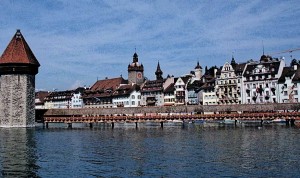 Town: AL CN; 15,000gp limit; Assets 9,000,000gp; Population 5,000; Mixed (90% human, 5% halfling, 2% dwarf, 3% other)
Town: AL CN; 15,000gp limit; Assets 9,000,000gp; Population 5,000; Mixed (90% human, 5% halfling, 2% dwarf, 3% other)
On the coast of the Jæruel, where the river meets the sea, lies Tannen (pronounced TAW-nen), a bustling seaport of a town built on sandy soil.
Architecture
The larger, more established buildings of Tannen are of sandstone and light wood from the forests harvested upriver near the village of Ches.
The buildings on the capitol grounds are of carved alabaster, taken from the mines east of Alabaster. The humbling, white edifice in the center of the city lies on a 5-acre plot surrounded by formal gardens decorated with flowers from the farthest reaches of the Jæruel. This is truly where the goods of the Jæruel comes together in an impressive display of what a successful merchant collective (some would say oppressive) can accomplish.
Layout
Along the banks of the river Ches runs a short wall of sandbags to keep the river in its banks in rainier months. Within five feet of these walls rise the older and more ornately-decorated buildings made of old hardwoods, including the town hall, the Jæruel central offices, the two inns that made Tannen famous (Inn of Golden Meadows and The Lark’s Nest), Smullivan’s Emporium, and, where the river meets the sea, the shipyard, where ninety percent of the seaworthy vessels in the Jæruel are built.
The town blocks off the river are devoted to residences, including the mayor’s house and on a low hill the wealthy neighborhood inhabited entirely by those in executive positions within the Jæruel, retired merchants who now manage their personal matters from their estates.
The rest of the town is a hodge-podge of market squares, shops on lower levels, and residences rising in the second and third storeys.
Key locations:
* Capitol Grounds – large, new construction that towers over town hall
* Town Hall – a converted keep that predates the town
* Jæruel Central Offices – new constructions across the river
* Twin Lighthouses – one in north-town and one in south-town
* Smullivan’s Emporium – market for many items
* Inn of Golden Meadows – standard inn named for the surrounding countryside
* The Lark’s Nest – exotic inn, featuring delicasies and fine things
* the shipyard – busy, working-class district where the river actually meets the sea
This town has served as the center of government for the Jæruel since the central offices of the merchant collective moved here two generations ago.
Map
(to follow in later post)
Personas
The Jæruel hierarchy represents the most notable personas in town. Galway Froid (mayor), Fennel Chatwid (head consulate), and Zann Diacon (finance minister) are the highest-ranking officials in Tannen.
The innkeeper owner of the Lark’s Nest is a boistrous legend. Of foreign descent and well-traveled, he tells stories the way most men tell lies, with the upmost of ease. Chariz Muqatad is known throughout the Jæruel, and there are those who visit Tannen just to meet him and hear his stories. In the process, he listens to their stories, which he uses to continue to embellish his own tales.
J.P. Smullivan is a trader who has recently joined the Jæruel, electing to pay his membership dues rather than risk losing his business to the town guard. Though less-than-friendly to new faces, largely due to this pressure to join the Jæruel, he is aware of much that transpires in Tannen and thus represents a great source of knowledge. The key is getting him to share it.
Plot Points
Each of the executives in the wealthy district finance treasure hunting expeditions and each have constant need for couriers and escorts. In addition, the Meldor House is known for financing voyages inland, past Westfort into the mountains and plains beyond. Zane Meldor is a known eccentric, known for his misadventures in the brothels in Tannen’s slums. He is ailing, and has been convinced that the fungal cure for his illness lies west of Westfort.
Smullivan is always after new supplies, especially those of an exotic nature. He knows of certain individuals who possess such items, and runs a secret business trading such items. Interestingly, it seems he has thieves steal from one Jæruel or Tannen city official which he then sells to another, and so on. He is likely to hire a party with an experienced enough thief to acquire such items from the homes of the wealthy.
Chariz Muqatad needs a message delivered to his extended family back in the dry lands to the far south, across the Old Bay. He is willing to pay handsomely for the message’s delivery. The message itself is so important that it has been stuffed inside a chicken, and must be delivered while the chicken still lives. This is an age-old custom for communicating among his people.
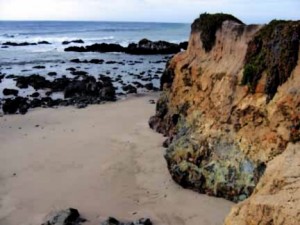 Galway Froid’s daughter, Ammrie has gone missing. Rumor has it she is being held for ransom, but there is no official word on this. If the party inquires too directly in official circles, they are likely to be taken to the dungeons beneath the town hall, a converted keep that predates the rest of the city, for probing and questioning. Others who have relevant information include Chariz Muqatad, who said he overheard some of the kids joking about staging an abduction, and Smullivan, who sold a load of face paint and robes to some of the local teens. The real story is that Ammrie had her allowance cut back and so she and her friends decided to stage a kidnapping to collect the ransom. It turns out, however, that when a local thug heard of this, he took her from her friends, and now holds her in a cliffside camp overlooking the sea to the north of Tannen, where he awaits delivery of the ransom sum.
Galway Froid’s daughter, Ammrie has gone missing. Rumor has it she is being held for ransom, but there is no official word on this. If the party inquires too directly in official circles, they are likely to be taken to the dungeons beneath the town hall, a converted keep that predates the rest of the city, for probing and questioning. Others who have relevant information include Chariz Muqatad, who said he overheard some of the kids joking about staging an abduction, and Smullivan, who sold a load of face paint and robes to some of the local teens. The real story is that Ammrie had her allowance cut back and so she and her friends decided to stage a kidnapping to collect the ransom. It turns out, however, that when a local thug heard of this, he took her from her friends, and now holds her in a cliffside camp overlooking the sea to the north of Tannen, where he awaits delivery of the ransom sum.
Once the teens are found, they will admit their part in the staging, and provide a description of the thug, who happens to be Thaddius Brewster, former employee of Smullivan’s. He used to lift large crates by himself and earned various nicknames for his feats of strength. If asked, Smullivan will mention Brewster’s departure from his shop lines up with the time of the supposed kidnapping. Once returned, the mayor will pay the party handsomely, though less than the original ransom. He is a shrewd merchant, after all!
The dungeons beneath the keep lead in various directions throughout the city. They are well-explored in the vicinity of the town jail; however, the secret, windy passages are said to hold more in store for an adventurous enough lot.
Posted in Encounter and tagged farghoal, Jæruel, Location, town by Stephen Hilderbrand with 1 comment.
Birthdays and Celebrations
Since today’s my birthday, and we’re in the midst of the holidays, I offer up this way to spice up your campaigns. For each nation and culture, come up with a day or two per month that has extra significance for either national or cultural reasons. Examples include Saint days (St. Repan’s Day, where the people tie wildflowers to their doors to honor the patron saint of wildflowers, etc.), Feast days, Fast days, Harvest days, New Years Day, Day of Moradin, etc.
To add extra flair, these days may increase or decrease skill check modifiers or have other effects. For instance, during the week around the summer solstice honoring Lux, the God of Light, hide and sneak checks are at a -5 penalty, whereas during the week around the winter solstice honoring Tenebrae, the god of Shadows, these checks are at a +5 bonus. This may correlate well with the crime sprees in a city, and may lead to the town guard being on high alert, a great way to introduce this bonus to the party.
Birthdays can also add bonuses to certain characters, which is why every character should have a birthday and a totem animal, so in February, the month of the Fox, a character celebrating a birthday receives bonuses befitting a fox.
Posted in Uncategorized and tagged event, fun by Stephen Hilderbrand with no comments yet.
Piran Point
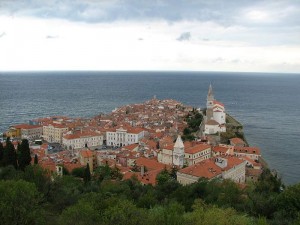 Town: AL CN; 2,000gp limit; Assets 900,000gp; Population 920; Mixed (70% human, 15% halfling, 5% dwarf, 5% gnome, 5% other)
Town: AL CN; 2,000gp limit; Assets 900,000gp; Population 920; Mixed (70% human, 15% halfling, 5% dwarf, 5% gnome, 5% other)
On the coast of the Jæruel, south of Tannen, there is a rocky point that juts out into the sea. This was once the home of a great serpent that fed on the schools of fish that swam around the point, as well as the occasional human who made their way here off-course from their intended destinations. This lair serves as the undersea port down the cliff from the main town center.
Architecture
The larger, more established buildings of Piran Point are hewn from the surrounding stone, a mix of limestone on the coast and granite further inland. More recent single-story buildings are of wood construction from the nearby oak, maple and pine forests.
Layout
At the top of the cliff, the town is laid out in a series of semicircles that run along the peninsula, the outermost being the poorest, and the region closest to the fresh water and woods the wealthiest. As the area was traditionally prone to piracy and attack by marauders, the wealthy moved farther and farther from the edge of the cliff, leaving their buildings unoccupied as they built increasingly more opulent estates inland. Because of this, there are various historic buildings that have been occupied by the working and non-working classes.
Encounters in this region include:
* low-scale thieves and pickpockets
* defensive family men
* various brawls and other pre-existing conflicts
Key locations elsewhere:
* St. Grisdon Square – where four churches come together in each of the cardinal directions
* Darkhouse Inn – featuring tinted windows; “what happens withinn stays within”
* Shelt’s Pelts – center of the halfling market
* Fishing Market – varieties of fish from varieties of merchants
* Town Hall – center of the village
This town has long been at the crossroads of merchants and rogues, lying within seven miles of three known robber barons, though this town has largely escaped their direct advances, as they have found the passersthrough along the broad roads more vulnerable and thus worth their effort. This has led to more armed caravans, which has reduced the frequency of their arrivals and departures.
Out at sea, there has been pirate activity as well, making Piran Point a refuge for travellers both by land and sea. Sea trade has mostly ended, the merchant vessels converted to fishing ships. Those vessels which sail into Piran Point are escorted by larger galleons decked out with many arms.
Map
(to follow in later post)
Personas
Piran Point is home to several merchant families of the Jæruel. Elton Thistlewood runs the local chapter of the merchant house, aided by Jossathon Radvell and Saldon Thede. Each keeps control over their own region of the merchant quarter.
Reverend Marden and Brother Sandis run the Cathedral of St. Grisdon, by far the largest of the four churches in the center of the town. In it, sermons to the words of the dearly-departed Grisdon, worshipper of a merchant-sect of Pelor’s younger brother Geld, and creator of the ten virtues of trade.
Plot Points
Tristega Thistlewood has split from her family and opened up a profitable business dealing in black market goods. Her father seeks to bring her back into the fold, and is willing to pay anyone willing to help convince her of this. The Radvells and Thedes have since made a play for power, realizing this distraction leaves the Thistlewoods vulnerable to infiltration and unable to rightly control their holdings across the town.
With this infighting among the merchant class, the streets have seen a rise in crime, the unorganized type that leads to confusion in the masses. Many poor have taken to picking the pockets of others, especially wandering parties. Of course, this news has not yet reached the lips of anyone in this town; why would they, when they profit from the unspoken truth.
The St. Grisdon sect of Geld has grown in influence among the more lawful-minded citizens of Piran Point, and can be called upon to assist the party if they uphold the ten virtues of trade. Tristega Thistlewood anonymously attends the sermons in the cathedral, and is a devout follower of St. Grisdon’s teachings.
Posted in Uncategorized and tagged farghoal, Jæruel, Location, town by Stephen Hilderbrand with no comments yet.